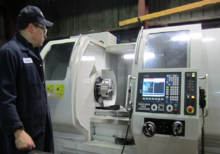


In machining, numerical control, also called computer numerical control (CNC),[1] is the automated control of tools by means of a computer.[2] It is used to operate tools such as drills, lathes, mills, grinders, routers and 3D printers. CNC transforms a piece of material (metal, plastic, wood, ceramic, stone, or composite) into a specified shape by following coded programmed instructions and without a manual operator directly controlling the machining operation.
A CNC machine is a motorized maneuverable tool and often a motorized maneuverable platform, which are both controlled by a computer, according to specific input instructions. Instructions are delivered to a CNC machine in the form of a sequential program of machine control instructions such as G-code and M-code, and then executed. The program can be written by a person or, far more often, generated by graphical computer-aided design (CAD) or computer-aided manufacturing (CAM) software. In the case of 3D printers, the part to be printed is "sliced" before the instructions (or the program) are generated. 3D printers also use G-Code.[3]
CNC offers greatly increased productivity over non-computerized machining for repetitive production, where the machine must be manually controlled (e.g. using devices such as hand wheels or levers) or mechanically controlled by pre-fabricated pattern guides (see pantograph mill). However, these advantages come at significant cost in terms of both capital expenditure and job setup time. For some prototyping and small batch jobs, a good machine operator can have parts finished to a high standard whilst a CNC workflow is still in setup.
In modern CNC systems, the design of a mechanical part and its manufacturing program are highly automated. The part's mechanical dimensions are defined using CAD software and then translated into manufacturing directives by CAM software. The resulting directives are transformed (by "post processor" software) into the specific commands necessary for a particular machine to produce the component and then are loaded into the CNC machine.
Since any particular component might require the use of several different tools – drills, saws, touch probes etc. – modern machines often combine multiple tools into a single "cell". In other installations, several different machines are used with an external controller and human or robotic operators that move the component from machine to machine. In either case, the series of steps needed to produce any part is highly automated and produces a part that meets every specification in the original CAD drawing, where each specification includes a tolerance.
- ^ "What Is A CNC Machine?". CNC Machines. Retrieved 2022-02-04.
- ^ "Automation - Numerical Control, Robotics, Manufacturing | Britannica". www.britannica.com. 2024-10-28. Retrieved 2024-10-31.
- ^ 3ERP (2022-06-24). "What is CNC Milling and How Does it Work: Everything You Need to Know - 3ERP". Rapid Prototyping & Low Volume Production. Retrieved 2022-06-30.
{{cite web}}: CS1 maint: numeric names: authors list (link)